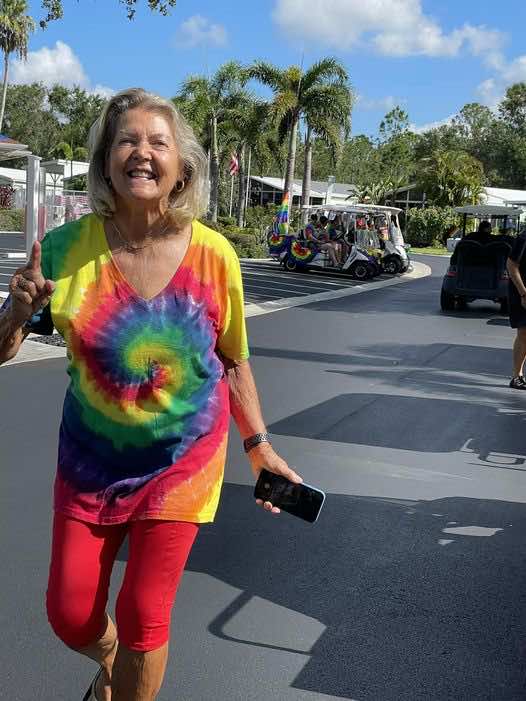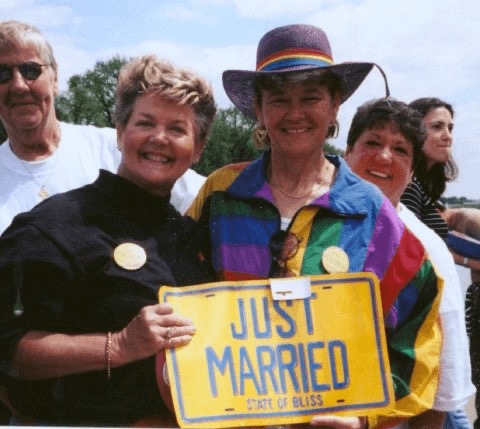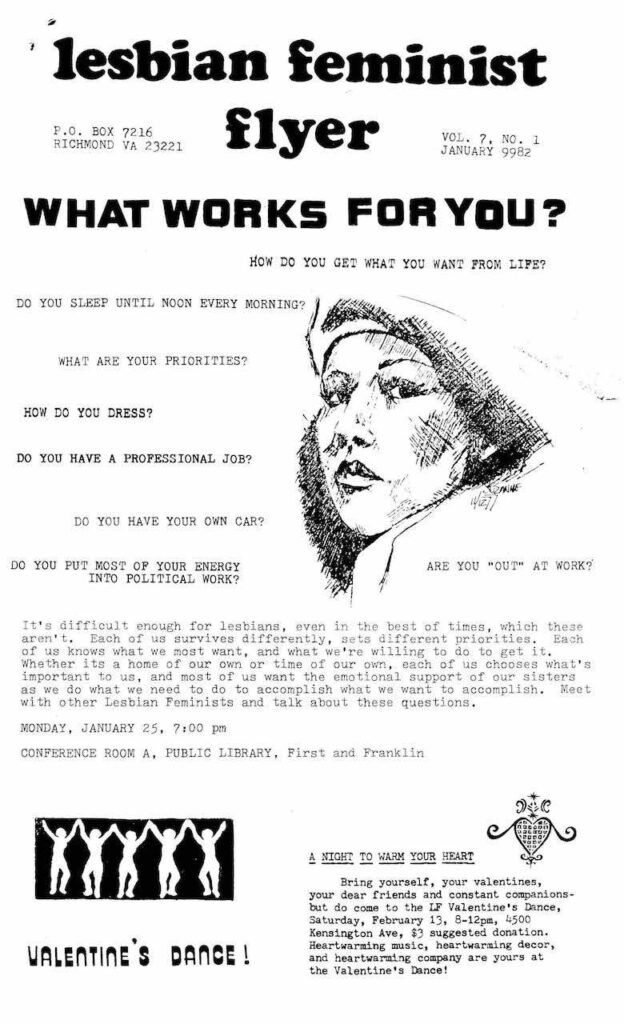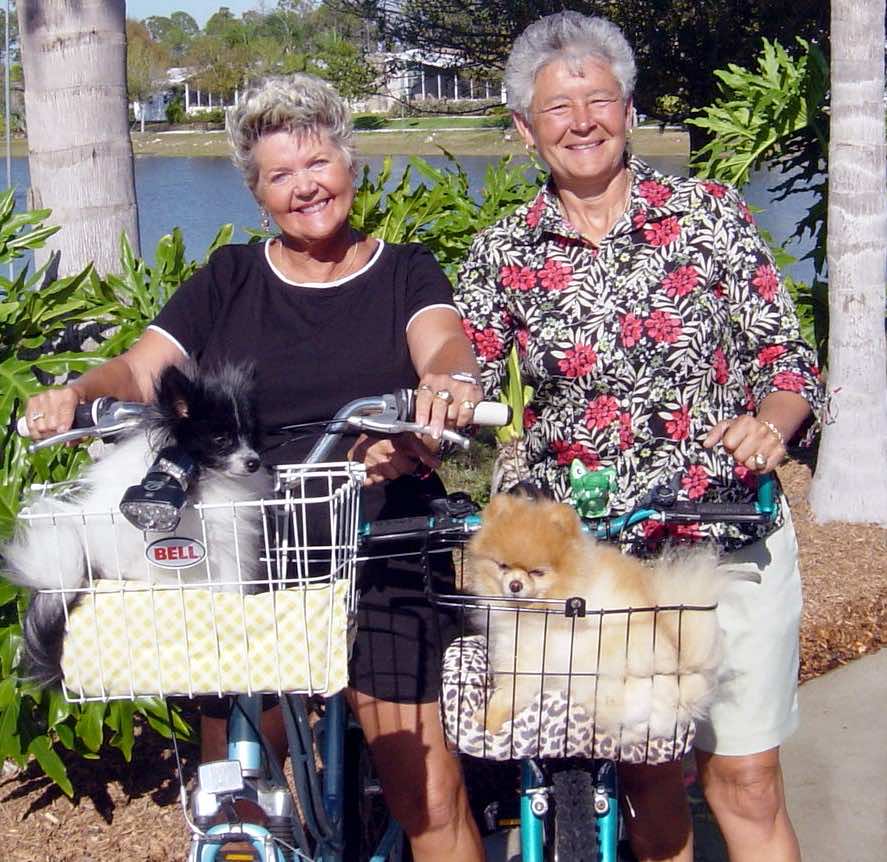Mary Gay Hutcherson: Cheerleader, Child Welfare Officer, Social Director for Richmond Lesbian Feminists

Interview by Rose Norman by phone on December 9, 2015
Childhood Influences
It wasn’t until I made that video interview [for Over the Rainbow] that I thought about how my early years were so heavily influenced by women because of my dad being in the military. I was at home most of the time with my mother or my grandmother. My mother always worked. She always made the important decisions. My grandmother was a farmer and a teacher.
After school, I’d go with her to the farms that she had, and we’d go with the sharecroppers to look at the crops. We’d go to the cotton gin to talk about the prices they were going to pay, and what they were going to charge her for seed. I would hear her debrief with me in the car afterward about not feeling she was treated fairly, thinking they were taking advantage of her, and having to be really strong, a tough thing to do. I think that made a real big difference in the way I viewed life, too, having all those strong women in my background.
Moving to Richmond
My husband was in a corporation, so every time he got transferred, I got a new job. When we moved to Richmond, I guess I worked at the child welfare office for awhile, and then I stopped working. That’s when I got involved in Richmond Lesbian Feminists (RLF) and NOW (National Organization for Women). There was another corporate wife whose husband had been transferred there at the same time we had. We decided that every morning we would read the Richmond Times Dispatch, which we called the Richmond Times Disgrace.
It was kind of the peak of the feminist movement, with the ERA (Equal Rights Amendment) fight, and they would have the most horrendous editorials in that paper. We would be incensed. We had been in Minneapolis before together, and there was a NOW chapter there, but everybody was so liberal there that there didn’t seem to be any need for activism. When we got to Richmond, we realized we had to find some women who thought like we did. We felt like fish out of water sitting out there in suburbia with all the other corporate people.
I remember going to the first NOW meeting with her. Everybody gave their zip code so we could connect with other people in our zip code. On the way home, we were wondering which ones were the lesbians. Soon I realized I was one of them. I think she probably did, too, although she got so disgusted with Richmond that they left. Her husband even left the corporation, and they went back to Minneapolis.
I was there when Sonia Johnson went over the White House fence, and I helped pay her bail.
RN: Can you talk about your involvement and political activism in NOW?
Biographical Note
Born in 1942 in Marmaduke, Arkansas, Mary Gay Hutcherson had many role models for women being in charge: her mother, grandmother, great grandmother, and lots of aunts.
After a move to Richmond, Virginia, Mary Gay became active in the National Organization for Women (NOW). It was at a NOW party that she met the woman who brought her out as a lesbian in her forties (the 1980s), ending her marriage.
In Richmond, Mary Gay was very active in lesbian and gay events, serving on many boards while remaining closeted in her job as a social worker in the public school system. She said, “I had one life in the daytime, and a totally different one at night. It was very challenging.”
(Read full bio.)
In 2000, approaching retirement, she came out publicly, and threw herself a big wedding . It was not legal to marry yet, but she did it as a personal and political statement.
MGH: At that time, things were really bad in Virginia. They’re much more progressive now, and they’re not that progressive, so you can imagine. That’s how I got active in NOW, and found women who think like I do. I connected immediately with somebody in my zip code, and we started doing all kinds of protests and activities. I just really took a plunge. It was really important to me. Of course, the ERA [Equal Right Amendment] was important to me, too, and we were close enough to [Washington] D.C. that you could easily get involved with an action or a rally in D.C. I was there when Sonia Johnson went over the White House fence, andI helped pay her bail. It was an interesting time.
We were constantly doing actions at the state capitol. I remember one protest at Travelers Insurance, protesting women’s rates for insurance being higher than men’s. That was covered really big and was in U.S. News and World Report with a picture of me holding a protest sign. My mother, being very conservative and Republican, read that magazine and saw my picture. That was the first time my mother realized I didn’t think quite like her. I wasn’t out then, but soon after was.
The women in NOW were mostly lesbians, I would say three-fourths. With the Women’s Political Caucus not quite so much, but the lesbians had a presence in the Virginia Women’s Political Caucus. I was active in the Democratic party, and we had a gay group within that. All of the organizations kind of blended. You saw all the same people in different organizations. One day you go to a NOW meeting, RLF tomorrow, and it’s pretty much the same people.
RN: The ERA failed to ratify in June 1982. That was such a deflating moment. When it was just over, that and the Reagan presidency, how did that affect you?
MGH: It was horrendous. Everything just kind of fell apart. We came to Richmond I think in 1979, and I think it was 1981 or 82 that I met Betty at a birthday party for a gal in Richmond Lesbian Feminists, but I think she was also in NOW. Betty was the one who looked like my ten-year-old crush Mary Catherine. I’m still curious about what happened to her. I lost touch with those elementary and junior high school friends after my parents divorced and we moved to another town when I was in 9th grade. Without a car, even if it was only fifteen miles away (and most people didn’t have a phone then), you lost touch with people. She was such a cute little butch. I hope she found herself along the way. Probably quicker than I did.
RN: You must have come to feminism long before you came to NOW.
MGH: I think I always was a feminist. I was always aware that women were not treated fairly, and I didn’t like it and would love to do something about it. But I didn’t find a path until I was in graduate school and started reading things, particularly Gloria Steinem. She was so active then, and I remember being very drawn to her. I still didn’t get active in feminist organizations until I moved to Richmond. I would certainly have identified myself as a feminist by the time I was in graduate school.
MGH: In January 1968 I graduated from college in Hawaii, and in June moved back to Arkansas for a few years. That was the period in which I began to read more feminist stuff and identify with the movement. I did things like, when I married the second time, I did not take his name, took no responsibility for what he ate or whether his clothes were clean. I decided on a totally different path for that marriage. Hutcherson is my maiden name, which I took back after my first divorce. I was so happy to have my name back.
RN: Can you describe some of the cultural activism you were involved in through RLF (Richmond Lesbian Feminists), such as dances, parties, art shows, camping at CampOUT, Our Own Community Press and WomenBooks? Particularly, talk about the some of parties you planned, or things like the Olivia party and the golf tournaments to benefit the women’s retreat center.

MGH: When I came out, it was a sudden thing. I met Betty and knew instantly where I was going. I didn’t know for sure it was going to be with Betty, but I could tell instantly this was where I needed to be. I met her at an RLF party. [NOW friends were invited to RLF parties, whether they were lesbian or not.] Whenever there was a party, everybody came. We would have a New Year’s Eve dance; mostly they were parties in people’s houses, or in the Quaker church where we met.
One lesbian bar, Babe’s, opened when I was coming out. It was a tiny little bar that later expanded to the other side, where they had a bigger dance floor. It’s still there, and it was the center of activity for all those years. That is actually where I met my wife, Yolanda. I danced there several nights a week in the 90s, when country line dancing became popular.
First Friday Potluck
The big contribution I gave to Richmond Lesbian Feminists was that, early on, I needed a social life. I’d always been so gregarious, and I didn’t know that many lesbians. So I gathered a group that was closest to me, about twenty-five of us, and we started having a first Friday potluck dinner every month. We called it First Friday Potluck. We were each supposed to invite every lesbian we knew. We started with twenty-five, the next month there must have been forty-five, the next month sixty-five, and it just grew exponentially. They met at my house for many, many years.
At one point, I thought I’d realized my dream of meeting every lesbian in Virginia. Everywhere I’d go, people would say, “Oh, yes, I’ve been to your house!” Within a year or two after I started the first Friday potluck at my house the group was huge, around a hundred, and I thought I needed to find a bigger place. Someone had a connection with a nun at St Joseph’s Villa so we rented space there, which I thought was ironic. We didn’t exactly say who we were and I can’t remember what name we used, but it didn’t go over very well cause so many women were closeted, and it seemed too public, so we soon came back to my house. I did that for a good 10-15 years. A lot of the women who came to my potlucks were not necessarily political, and some might not even have thought of themselves as feminists, but they wanted to know other lesbians. Of course, the core was RLF people, and they were political. It was a real melting pot.
Richmond Lesbian Feminist Flyer

I also wrote the RLF Flyer for many years, and after we went to computer, I was at every event with my email list handing out copies of previous issues and trying to get people to sign up to get the Flyer. Lots of people who got the Flyer never did anything else because they were too concerned about getting outed. Most of lesbian life in Richmond was just little groups of people– ten lesbians did everything together. Richmond Lesbian Feminists pulled a lot of those people together. But a lot of them never got involved, unless they got out of a relationship and came to a potluck to meet women. They used to joke that I could sell my mailing list for a million bucks. The Richmond Lesbian Feminist hotline rang in my house, too.
WomensBooks and Olivia
I was involved in Richmond WomensBooks. I was on that board and did work hours. It was a book coop downstairs from a food coop. I was at a board meeting when there was a letter from Olivia Records. We sold Olivia records in the book cooperative. They were starting to do cruises, and they wanted someone to give a party to introduce the local women to the concept of Olivia. Of course, when they said “have a party,” everybody in the room looked at me. So I said, of course, I’d do it.
There was a new bar in town, The Pyramid, kind of a classy bar with lots of tv’s, primarily a men’s bar. They agreed to do the party. Babs Daitch, activity coordinator for Olivia, came and she gave me a two-for-one cruise for doing the party. My girlfriend at the time had just gotten a new job, so she couldn’t go. I asked my tennis partner to go, and on the cruise she fell in love with Babs Daitch, the activities coordinator. So everybody in Olivia knew me as the friend that came with her. I later worked a little with Olivia as a solo coordinator on a cruise. I would go to wherever there was an event with a lot of lesbians, and help set up the information booth, things like that.
RN: You said that there are 50 to 75 married couples at Carefree?
MGH: There were fifty the first time we got together and had a reception and marched in in order of when we got married. Of course, the first couple was Canadian, because they could [marry] when we couldn’t. It was really kind of cool. It was the first time we had experienced being announced as married couples, and it was before it was legal in Florida, about two or three years ago. I’m sure there are at least 25 more couples since then, so there must be at least, minimally, 75 married couples now at Carefree, and we have around 400 lesbians here in season, I guess. [This was in 2015.]
InTouch (now CampOut) and Carefree
CampOut started out as InTouch, started by a couple of friends of mine on land halfway between Charlottesville and Richmond. [CampOut is a members-only, private campground for women and home of the Virginia Women’s Music Festival.] Janet Grubler was director. They had investors and purchased the property, and we all helped build a stage and have music festivals. I organized golf tournaments, partly as a fundraiser, but more as a public relations thing for people who might not want to go out and camp at InTouch, or even get involved in those activities. I still wanted them to have a connection.

The golf tournaments were for lesbians, held at different golf courses in Richmond. That’s where I met the developers of Carefree, Gina Razete and Cathy Groene. They found InTouch and came to see it and meet the director. When they found out there was a golf tournament, they asked to have a display there, and we organized times for people to come and talk to them about what was going on at Carefree. Carefree broke ground in 1996 and opened in 1997. They flew me down to see it, because I talk to so many women (my goal was to meet every lesbian in the world) and do the Olivia things. I really liked the concept, and I’m surrounded now by people I’ve known for years and years. It is a marvelous place.
This is totally a sideline, but I live in this lesbian resort, and the vanity tag on my golf cart is Mary Gay. One day, I’m walking home and two women are standing there looking at the license plate. They said, “We wondered if there was more than one Mary Gay in the world!” They had been in my solo group on the Alaska cruise about twenty years ago. Four people on that cruise later became couples that I know of, and many women became couples after meeting at my potlucks. One of them is now at Carefree. It’s a small lesbian world.
Gay Film Festival and Run for Equality
We had a gay film festival, primarily sponsored by the Pride organization, which had members from each of the different organizations. I was often the member from Richmond Lesbian Feminists, and usually Beth Marschak was. I chaired Pride one year, and I’m sure Beth did, too. I chaired the film festival one year. We would have it at VCU [Virginia Commonwealth University]. I also chaired the Run for Equality on Women’s Equality Day.
Festivals
At Pocahontas State Park we would have our RLF annual convention. The book coop, RLF, the Pride committee (made up of a conglomerate), and women would come from all over the state. We would also go to Sisterfire in Washington, D.C. and Campfest in Pennsylvania, and in Roanoke there was a festival at a state park.
Working in the Closet
RN: I’m intrigued by your statement that you were able to remain completely closeted at work for the school system while at the same time living an active and eventful life in the lesbian and gay community. How did you manage that?
MGH: It was the strangest thing, when I look back on it. We had this network of gay people who were all connected, but we were practically all closeted, because most people had jobs they would lose if it was known. For somebody who was so gregarious, I learned early on not to be. I was just superficially connected to the school system socially. I went in, did my work, went home. I didn’t do anything social with those people. If there was another gay person in a school, that was great.
In most of my schools, I eventually found somebody who was gay. There was usually a teacher or a principal or a gay staff member in every school. With them, for a moment you could be whole. One of my principals was a lesbian, and we would manage to find brief moments to be together and let our guard down. But then it would have to go back, because you had to walk this other personality. Then as soon as I left the school, I was me and I had a whole different life. When I was straight, my social friends and my work friends were likely to be the same, but after I came out that was not true at all.
Few Women of Color
RN: Richmond has a majority Black population, yet most women’s organizations, like NOW and the Women’s Political Caucus, had no women of color as members, and RLF had only 10-20%. How do you account for that?
MGH: There was very little interaction between the women of color and their feminist organizations and ours. It was so strange. We always had our New Year’s Eve party at the Bon-air, and the Black lesbians were going to the downstairs part, and the white lesbians were going to the upstairs part. A few of us knew each other and went back and forth, but I think that’s the most connection we had. I don’t remember ever seeing a Black woman at Richmond Lesbian Feminists. I knew Terrie Pendleton, because she was also a social worker. She may have come to a Richmond Lesbian Feminist dance, probably not a meeting but a dance.
I did know Jacqui Singleton. In fact, she sang out our first wedding at MCC [Metropolitan Community Church] on Valentine’s Day 2000. She sang “My Funny Valentine.” I don’t think she ever came to Richmond Lesbian Feminist RLF things, but we did have a bar life together, and I knew her.
[Jacqui Singleton was a talented Richmond singer, novelist, and playwright, co-founder of Richmond Triangle Players in 1992. Her band played for RLF parties sometimes. She died in 2013.]
This interview has been edited for archiving by the interviewer and interviewee, close to the time of the interview. More recently, it has been edited and updated for posting on this website. Original interviews are archived at the Sallie Bingham Center for Women’s History and Culture in the David M. Rubenstein Rare Book and Manuscript Library at Duke University in Durham, North Carolina.
